First of all, during this special COVID-19 quarantine time I want to wish you a healthy Easter ! I hope nobody in your family has been impacted by the corona virus. In my family we have nobody infected so far but social distancing remains important. This quarantine time, our teenagers have a lot of time. My two teenager sons received late last year both the book Rich Dad, Poor dad after a financial literacy class. During this Stay at Home time, I challenged both sons to complete the reading of the book.
Since its debut in 1997, Robert T. Kiyosaki’s Rich Dad, Poor Dad has been a landmark among personal finance books, a best-seller that has sold more than 40 million copies worldwide. I first read the book back in 1995, when I started to build my financial literacy skills. One son completed the reading and he also created a presentation about the key learning of each chapter. During a 30 minutes presentation he walked me through the different insights he gained from reading this book.
It started with the chapter 1 MINDSET. He explained me why it was important to learn how money works. Let money work for you !
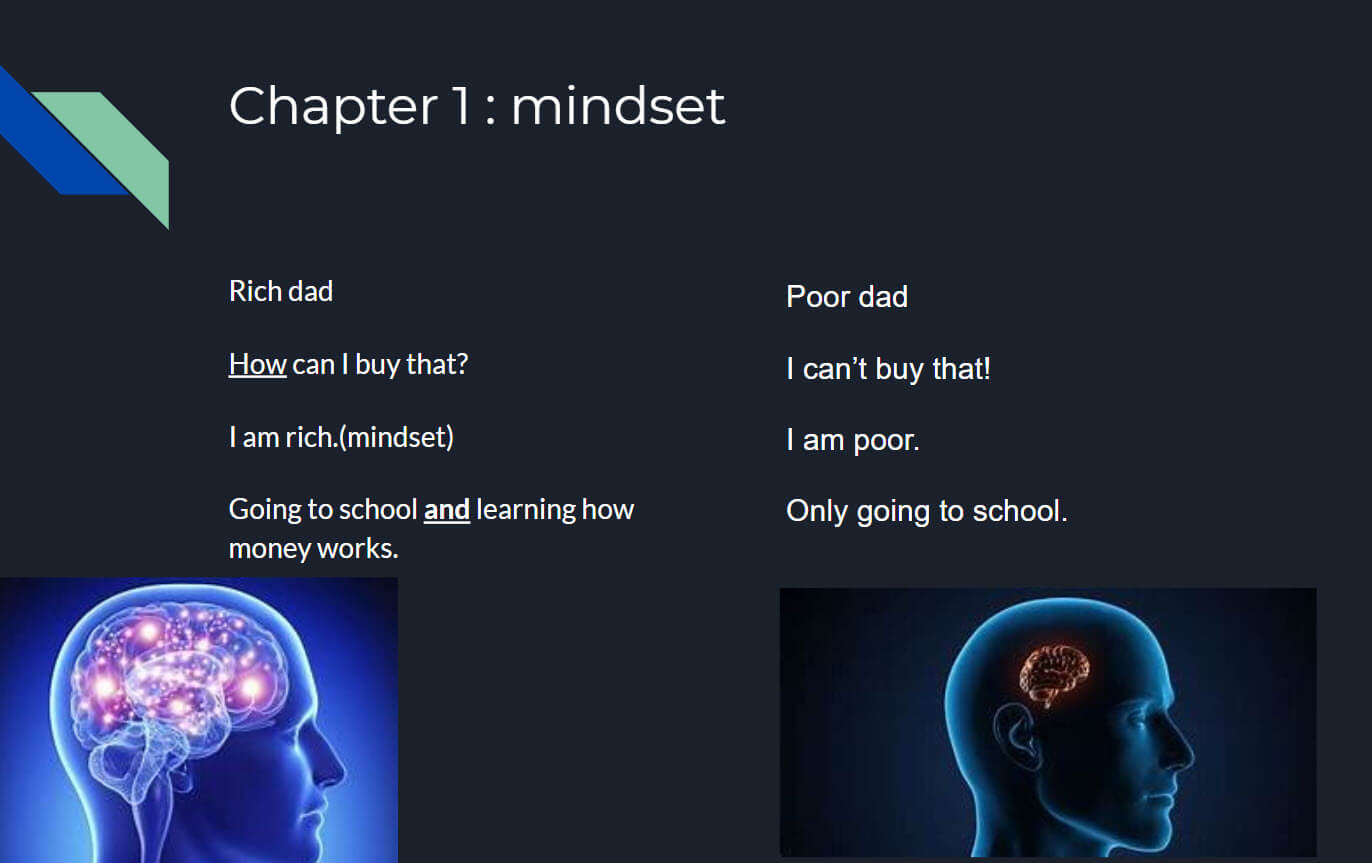
It was interesting to see how he plugged in images he grabbed from the Internet, to make his point he wanted to present. In Chapter 8 he explained why learning how money works, is not for everyone. He summarized 8 reasons why people don’t act. 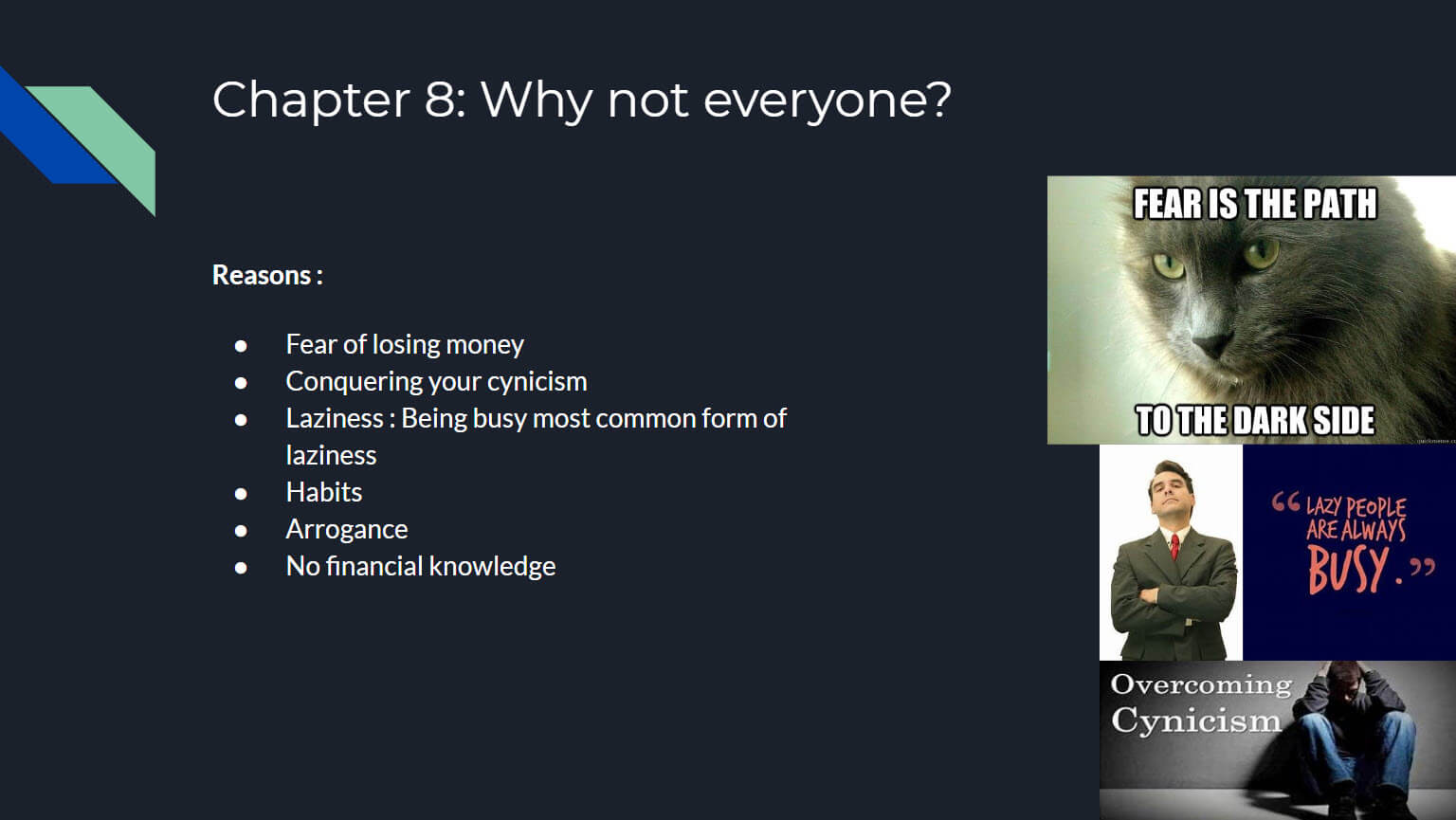
During the presentation, I asked several questions to review his in depth knowledge or understanding of a topic. Especially during chapter 9, we reviewed the ten steps that contribute to build a financial literate mindset.
Take a look at the full presentation of my 15y old son. My other son hasn’t opened the book yet. One day maturity and interest will kick in. We just have to be patient and motivate them to learn.
Market Sentiment and Sector Watch
Where are we today in the market sentiment ? Are we in the denial phase or are we in the overconfident phase ? Investors who bought at the lows, have experienced in the past 20 days a strong rally, not seen since 1974.
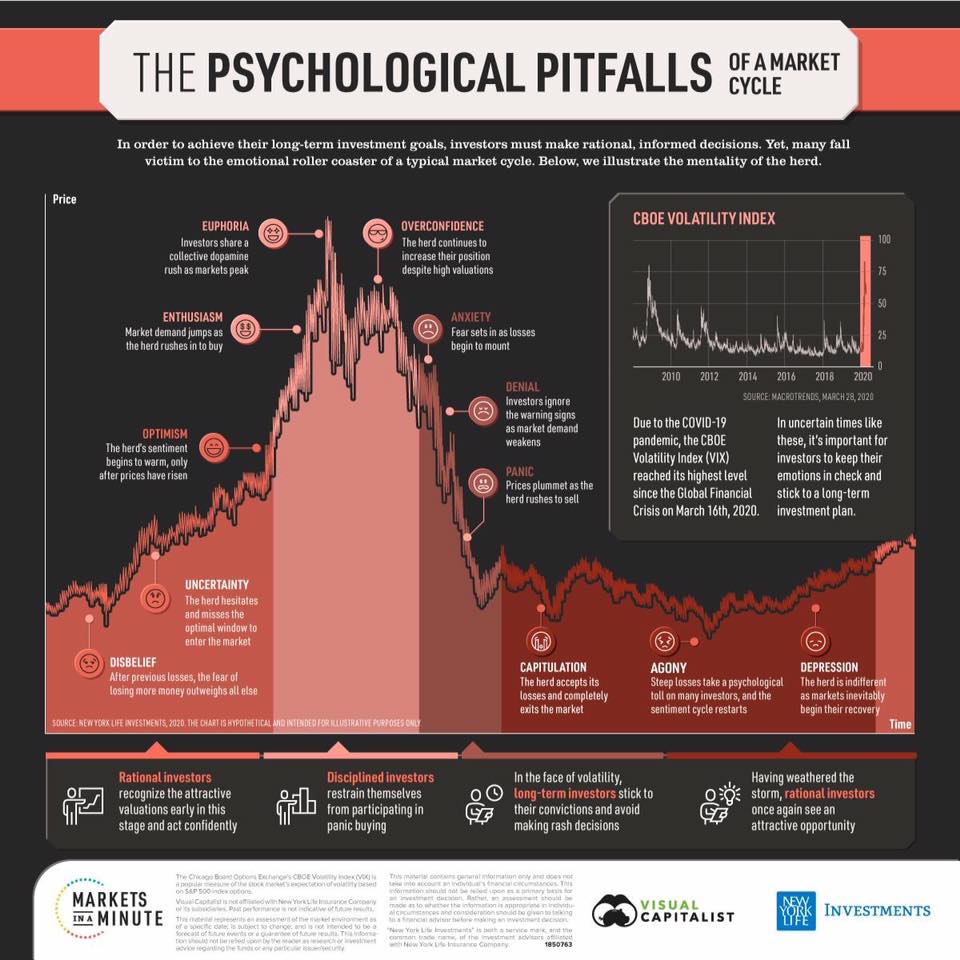
Stocks have outperformed bonds by 11.97 percentage points during the last 20 trading days. This is close to the strongest performance for stocks relative to bonds in the past two years and indicates investors are rotating into stocks from the relative safety of bonds.
The winners
- E commerce marketplaces : Names such as Amazon, JD.com. Find some extra names listed by JP Morgan.
- Pharmaceuticals : Pharmaceutical companies are inevitably playing a large role in the crisis. Gilead, which owns the rights to treatment drug Remdesivir; Moderna, actively working on a vaccine; Roche, a major supplier of testing kits; and Fujifilm, with existing treatment drug Avigan, are all poised to benefit.
- Logistics & delivery : As people around the world are blocked from leaving their homes, products and services will need to be delivered. You can look at the traditional names such as Fedex, DHL and other names.
- Videoconferencing : Webex from Cisco and Skype and Teams from Microsoft are seeing major upticks in sales. Most are offering special deals for their conferencing services during the outbreak. Videoconferencing start-up Zoom has benefited massively. The company’s sales and share price are already up over 50% in 2020, although more companies and universities are banning the service as it has major security and privacy flaws. The company is now trying to address those issues at increased pace.
- Entertainment streaming and gaming : Platforms like Netflix, Amazon Prime video, and Disney+ all report increased viewership. Online gaming platforms are also experiencing record volumes. I notice that many friends view more content on those streaming services.
- Online education and remote learning : During this outbreak, many schools and universities have turned to online education and EdTech companies have found an opportunity here as worldwide traditional learning/training institutions are trying to adapt and accelerate their transformation to remote teaching. The online education sector in China is experiencing a boom as schools nationwide are suspended, according to data from research firm Sensor Tower. The biggest winner appears to be TAL Education’s Zhang Bangxin, who saw his wealth increase by $1.7 billion, giving him a current net worth of at least $10 billion. Zhang has surpassed the likes of JD.com’s founder Richard Liu ($8.7 billion) and Baidu’s Robin Li ($7.1 billion) to reach number 24 on China’s wealth rankings. TAL has partnered with more than 300 public schools across China to stream free classes, and its providing complementary K-12 online tutoring sessions. Other education companies are also launching more e-learning courses while developing data tools to analyze student performance and help teachers track their progress. As the virus continues its spread in several countries and as more universities and schools have moved online in the wake of the corona virus, this trend might be a natural marketing campaign for EdTech companies.
The losers
For the losers, their managements will need a Herculean effort to pull them through the crisis. Even if they succeed, many will be seriously damaged. The natural strategy in these sectors will be to cut costs, de-risk operations and be ready to return when conditions improve.
- Airlines, trains and cruise ships : The global airline industry has said it will need up to US$200 billion (£171 billion) in emergency support, and Boeing has called for US$60 billion (£51 billion) in assistance for aerospace manufacturers as the international travel industry bleeds cash. Virgin Atlantic intends to park up to 85% of its fleet during the month of April and is asking staff to take up to eight weeks unpaid leave over the next three months to avert job losses.
- Oil and gas : On January 1, a barrel of crude oil sold for US$67.05 on New York’s NASDAQ exchange. At the time of writing, it was trading at around US$26 per barrel. So companies’ oil reserves are worth less than half that of the start of the year. The value of giants like BP reflects this – on March 19, it was worth 51% of what it was at the start of January. Past week, the OPEC meeting resulted in a conditional oil cut production agreement of 10 Million barrels per day. But it’s uncertain that this agreement holds as Mexico didn’t agree.
- Tourism: The US Travel Association is projecting that close to 5 million travel-related American jobs will be lost. This is more than 25% of the 15.8 million Americans who work in the sector. The situation is equally dire elsewhere. For example, all ski resorts in Italy, France, Austria and Switzerland are effectively closed for the season.
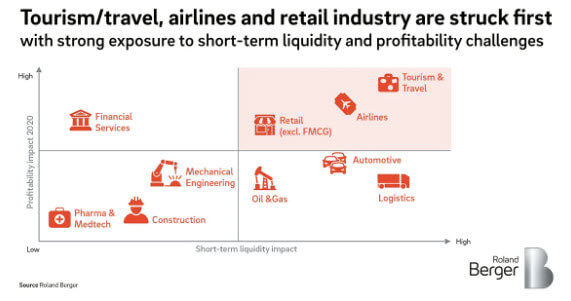 Professional Sports and entertainment : Italy, Europe’s worst-hit country, cancelled all sporting events until at least April 3. France, Spain, Germany and the UK quickly followed suit. This year’s Copa America and Euro 2020 football tournaments have been postponed until 2021. Also cinemas are closed. Analysts predict that the global film industry is facing a US$5 billion (£4.2 billion) loss from diminished box office revenues and production restrictions. That could grow if more countries force people to remain at home or order public space to close. In Belgium all summer concerts will most likely be closed causing a 60 to 80% decline in revenue for all companies working in the music and concerts sector.
Professional Sports and entertainment : Italy, Europe’s worst-hit country, cancelled all sporting events until at least April 3. France, Spain, Germany and the UK quickly followed suit. This year’s Copa America and Euro 2020 football tournaments have been postponed until 2021. Also cinemas are closed. Analysts predict that the global film industry is facing a US$5 billion (£4.2 billion) loss from diminished box office revenues and production restrictions. That could grow if more countries force people to remain at home or order public space to close. In Belgium all summer concerts will most likely be closed causing a 60 to 80% decline in revenue for all companies working in the music and concerts sector.- Traditional retail : With people confined to their homes, there isn’t much point keeping traditional retail stores open. The largest US mall owner, Simon Property Group, announced on March 18 that it would close all its malls across the country. Similar decisions have been made across Europe and Asia. In Belgium, some traditional retailer chains will not survive the corona crisis. They do not have the financial power to buy their autumn collection as they can’t sell of their spring and summer cloths collection.
- Investment banking : Hundreds of London and New York investment bankers are set to lose their jobs amid a slump in deal-making. Shares of leading US banks JPMorgan Chase, Bank of America and Citigroup are all down more than 30% from January highs. Financial News spoke to senior London investment bankers who predicted a drop in fees of up to 50% in the first six months of 2020. That would mean around US$10.7 billion (£9 billion) in lost revenues across equity deals – the worst first half of a year since 2009.
The Inbetweeners
These sectors will probably struggle if they continue as is. Many companies will fail, though a few will adapt their business models to take advantage of new and emerging opportunities. In some cases, this will build a solid foundation for continued success.
- Healthcare : Some players in this sector emerge with new ideas that could improve healthcare. Others will be pushed past breaking point and will never return. Chinese digital firm Baidu is among those that has been quick to innovative. It launched a Fight Pneumonia app to help the public get accurate and useful information about the epidemic in real time. It is also offering its online medical advice platform free to users seeking COVID-19 consultations. This has seen over 100,000 doctors across China responding to tens of millions of inquiries.
- Banking : Most banks will lose money as individuals and businesses struggle to pay back loans. If the world economy enters a recession, which seems very likely, the market for financial products will also fall. Banks can, however, generate goodwill with businesses that need assistance, and create relationships with new customers. Several UK incumbents, including Barclays, Santander and RBS, are already offering emergency loans and overdrafts to at-risk business customers. Many consumers will need temporary solutions, which could yield a spike in demand for small and medium-sized loans.
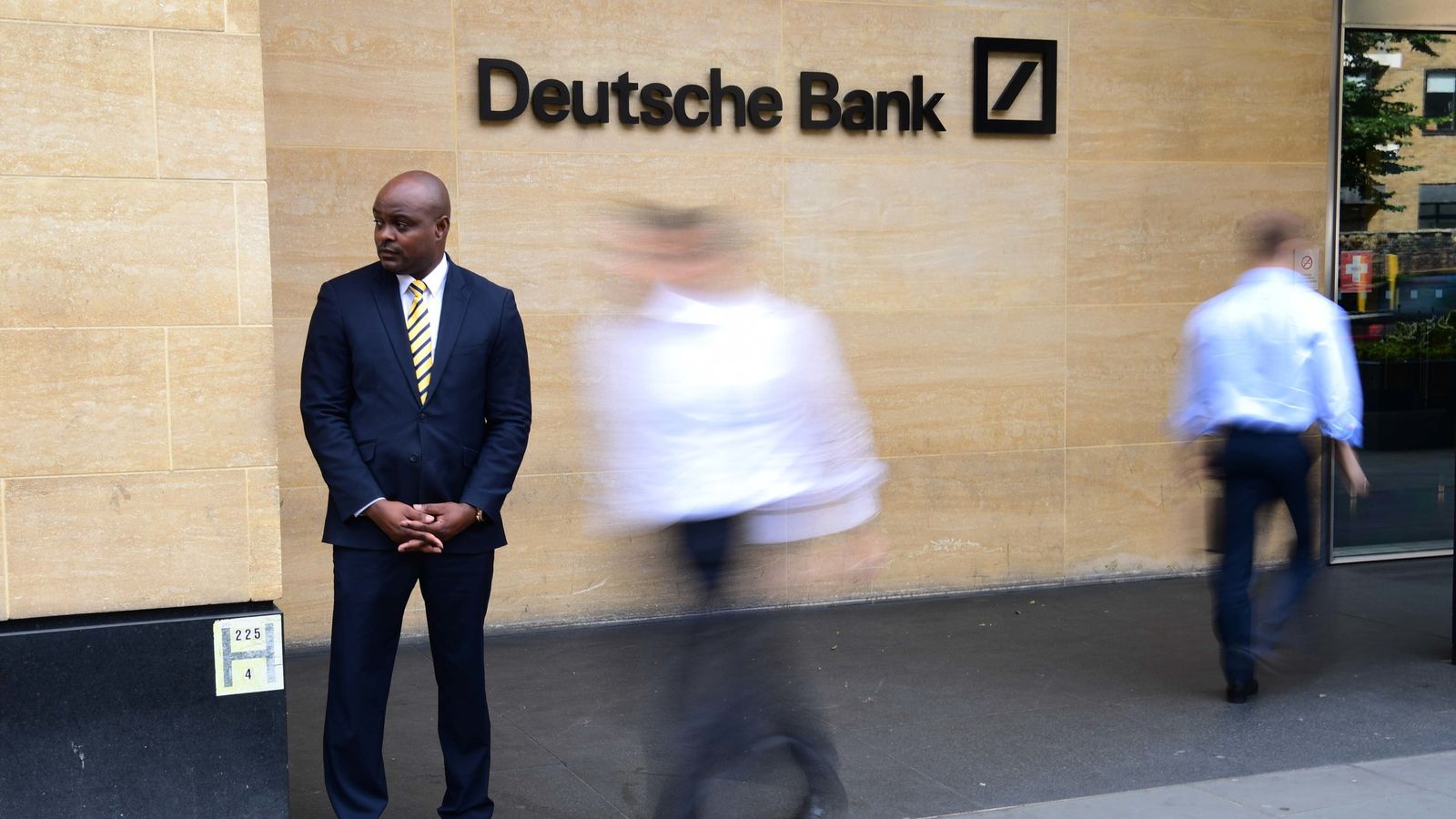
Sectors differ in their ability to respond flexibly to supply disruptions and falls in demand. Business as usual can continue for professional services if their workforce logs on from home, but this is not an option in most other sectors. Where staff are employed on temporary or zero-hours contracts, sectors can reduce their staffing costs while demand is down, but in most cases these costs are a small proportion of running costs.
Once a global recovery gets underway, industrial production and wholesale trade might be able to catch up some of the lost ground. There will also be some catch up for retail trade as some purchases that were postponed are finally made. But seasonal products will have missed their moment, and events, journeys and meals out may have been cancelled rather than postponed. Consumer confidence may take time to recover, and consumers may have drawn on savings during the period where they were unable to work. In the construction and health sectors, supply capacity will limit how much of the pent-up demand can be met. Credit markets have been responding to the increased risks for some sectors, and yields have risen dramatically since the beginning of February. Most sectors have already issued debt to around 20%-30% of their refinancing needs for 2020, but the large increases in refinancing costs are worrying in highly leveraged sectors, and those with large refinancing needs, including the energy, health, and car-making industries. Understand how resilient each sector is to rebound to normal if this pandemic period will be over. We just don’t know when this will end.
Passive Income Update
During the January – March 2020, we received 102,78$ dividend. A great addition to our kids cash position.

Final Thoughts
Our kids portfolio has now 3000 Euro Cash. We will review whether we can identify interesting put options for stocks or ETFs we want to own in the near future. If the stock markets take another leg down, it could be interesting to pick up some value dividend aristocrats names or write puts on them to pick them up at a cheaper price.
Last year we made 1000$ writing puts on JNUG. This year, I haven’t done any put writing in this portfolio yet. We need to pick up this strategy again. Above you can see we have earned more than 3000$ in dividends and options premium in this portfolio.
Sources : TheConversation, BusinessInsider
If you haven’t subscribed to our newsletter yet, please do so. Life can be busy sometimes and people lose track of following a personal finance and travel blog. Subscribe and you will get one email per month highlighting what you missed…
Thanks for following us on Twitter and Facebook and reading this blog post. We end with a quote as always.
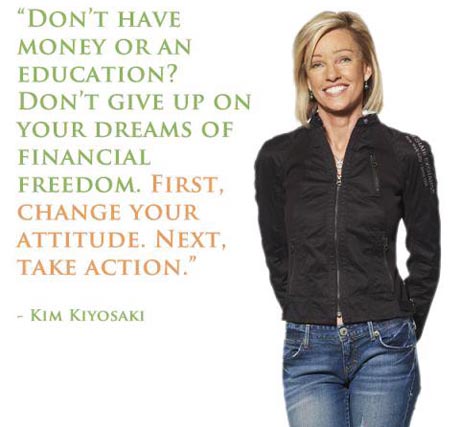

No Comment
You can post first response comment.